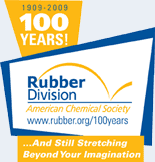![[ Visit ACS Rubber Website ]](images/logo.jpg) |
|
Centennial Elite SponsorsBecome a Centennial Elite Sponsor |
4 Filler Reinforcement – New InsightsTuesday, October 13, 2009: 9:30 AM
330 (David L. Lawrence Convention Center )
We consider reinforcement of rubbers under varying dynamic mechanical loadings. Especially, we focus on the kinetics of filler agglomeration after repeated changes of dynamic amplitudes. We will demonstrate how the so induced internal filler kinetics is related to filler cluster flocculation during annealing in a rubber processing analyzer. From an academic point of view it is interesting to note that dynamic strain-induced non-linearity in the modulus of filled rubbers show a striking similarity to what is known about the glass transition of solid materials and the jamming transition of granular materials.
A study of the kinetics of the modulus recovery with experimental set-ups, where the stiffness response on repeated amplitude steps was measured, gives proof of the breakdown and recovery of a filler network. We study the stiffness response on repeated amplitude steps, and we demonstrate how stiffness recovery can be described by a logistic saturation model which has similarities to segregation models in social science, and which is obviously of relevance for aggregated growth in soft systems. A similar description is possible in case of flocculation kinetics of pyrogenic silica nanoparticles (Aerosil 200) in an EPDM elastomer sample without curing chemicals in an oscillating die rheometer. After a sudden breakdown of the filler network caused by an application of 24 % strain, the storage modulus G’(t) is found to slowly increase with time. After around 70 min G’ recovers its initial equilibrium value (G’∞). Another example of flocculation kinetics is shown within an oscillatory shear rheological experiments on polycarbonate melts with 5 wt.% carbon nantotubes where two recovery processes could be identified. Flocculation on all explained systems can be described by the same physical basic model. We finally note that the consideration of “reinforcement kinetics” within the development processes for advanced rubber compounds allows a better control of material properties and a more fundamental engineering praxis in rubber industry. In particular, FE simulations of the stress-strain properties of filler-reinforced elastomers are an important tool for predicting the service live performance of rubber goods. Other typical examples are the evaluation of rolling resistance of tires due to hysteresis energy losses, mainly in the tire tread, or the adjustment of engine mounts in automotive applications. |









